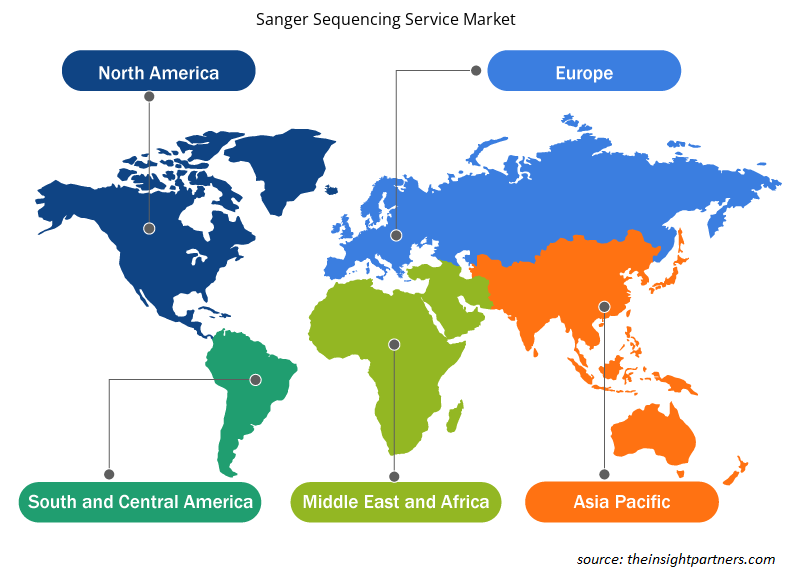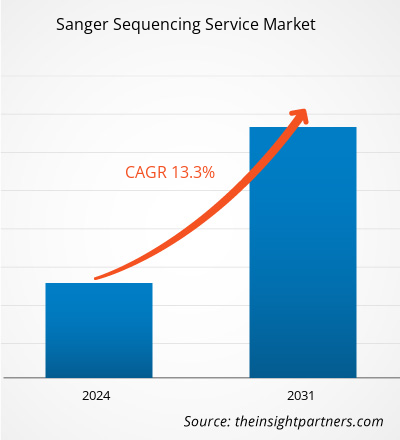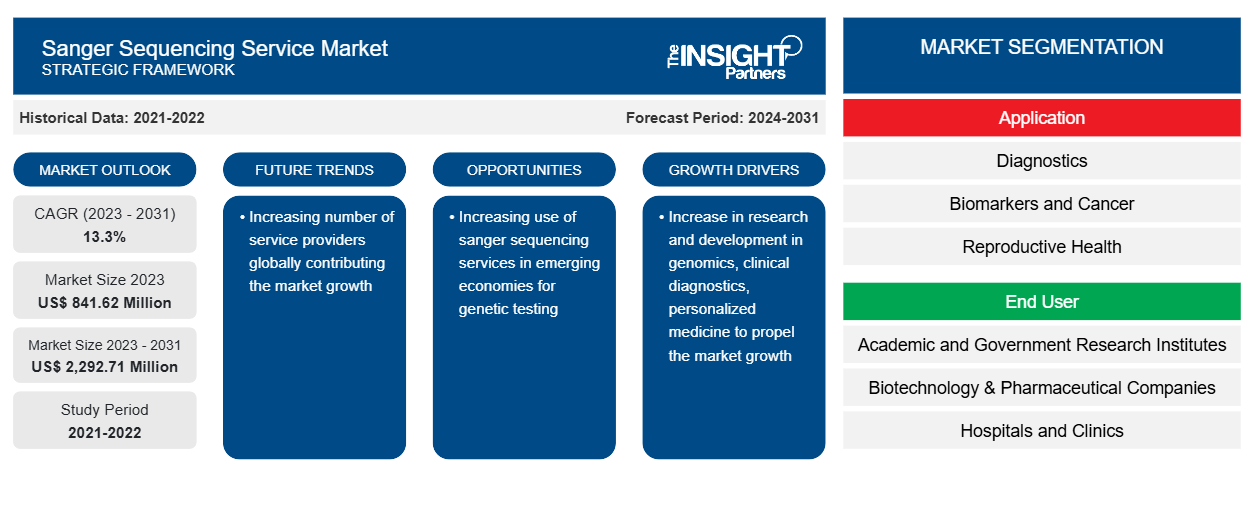Si prevede che la dimensione del mercato del servizio di sequenziamento Sanger raggiungerà i 2.292,71 milioni di dollari entro il 2031, rispetto agli 841,62 milioni di dollari del 2023. Si prevede che il mercato registrerà un CAGR del 13,3% nel periodo 2023-2031. È probabile che il numero crescente di Next-generation Sequencing e l'adozione di automazione e robotica rimangano tendenze chiave nel mercato.
Analisi di mercato del servizio di sequenziamento Sanger
Il mercato dei servizi di sequenziamento Sanger è guidato dalla crescente ricerca e sviluppo in genomica, tra cui il sequenziamento genomico, la profilazione dell'espressione genica e l'analisi delle variazioni genetiche. Il sequenziamento Sanger rimane uno strumento prezioso per la convalida dei dati NGS, il sequenziamento genico mirato e altre applicazioni specifiche di ricerca genomica. Inoltre, si prevede che anche la crescente adozione di diagnosi cliniche e medicina personalizzata contribuirà alla crescita del mercato. Il sequenziamento Sanger svolge un ruolo importante nella diagnosi clinica per l'identificazione di mutazioni genetiche associate a disturbi genetici, cancro e altri disturbi. Inoltre, la crescente adozione di medicina personalizzata e la necessità di test genetici precisi stanno contribuendo alla crescita del mercato. Tuttavia, si prevede che il crescente utilizzo di servizi di sequenziamento Sanger nelle economie emergenti creerà ampie opportunità per la crescita del mercato nei prossimi anni.
Panoramica del mercato del servizio di sequenziamento Sanger
Si prevede che il mercato dei servizi di sequenziamento Sanger registrerà un tasso di crescita significativo dovuto all'aumento della ricerca e sviluppo in genomica, diagnostica clinica , medicina personalizzata e altri, insieme al crescente numero di fornitori di servizi a livello globale. Inoltre, si prevede che l'aumento dell'uso dei servizi di sequenziamento Sanger nelle economie emergenti creerà opportunità nei prossimi anni. Il segmento dei biomarcatori e delle aree di applicazione del cancro rappresenta la quota di mercato più ampia a causa dell'aumento dell'incidenza del cancro, della crescente ricerca sui biomarcatori del cancro e del crescente utilizzo dei biomarcatori del cancro nella scoperta di farmaci e nella diagnostica. Inoltre, nel 2023, il Nord America rappresenterà la quota maggiore nel mercato globale dei servizi di sequenziamento Sanger e si prevedeva che avrebbe avuto la quota di mercato più elevata nel periodo di previsione. La crescita del mercato dei servizi di sequenziamento Sanger in questa regione è guidata principalmente dalla crescente ricerca sul cancro, dai finanziamenti e dagli sviluppi per la genomica e la medicina di precisione. Tuttavia, l'Asia Pacifica è la regione in più rapida crescita a causa delle crescenti attività di ricerca e della crescente presenza di importanti attori del mercato che stanno guidando la crescita nella regione Asia Pacifica.
Personalizza questo report in base alle tue esigenze
Riceverai la personalizzazione gratuita di qualsiasi report, comprese parti di questo report, o analisi a livello nazionale, pacchetto dati Excel, oltre a usufruire di grandi offerte e sconti per start-up e università
-
Scopri le principali tendenze di mercato in questo rapporto.Questo campione GRATUITO includerà analisi di dati che spaziano dalle tendenze di mercato alle stime e alle previsioni.
Driver e opportunità del mercato del servizio di sequenziamento Sanger
Aumento dei fornitori di servizi e applicazioni di sequenziamento Sanger per favorire il mercato
Le aziende fornitrici di servizi di sequenziamento Sanger stanno espandendo la loro portata globale sul mercato e svolgono anche un ruolo significativo nell'aumentare l'adattabilità delle tecnologie di sequenziamento in tutto il mondo. Ad esempio, a giugno 2023, Source Genomics, una parte del gruppo Source BioScience, ha aperto un nuovo laboratorio nel nord dell'Inghilterra. Ciò fornirà il servizio di sequenziamento Sanger leader del settore di Source Genomics al territorio settentrionale con tempi di consegna più rapidi per una consegna dei dati ottimizzata.
Inoltre, negli ultimi anni, il sistema CRISPR-Cas9 è stato stabilito come tecnica di editing negli organismi complessi. Questo sistema è ampiamente considerato come una scelta per i vantaggi offerti, come la convenienza, la facilità d'uso e l'elevata efficacia delle modifiche mirate desiderate. Tuttavia, negli esperimenti di editing del genoma, il processo di riparazione non è completamente accurato; pertanto, l'analisi dei frammenti o il sequenziamento Sanger mediante elettroforesi capillare (CE) vengono utilizzati per determinare l'efficienza dell'editing del genoma mediato da CRISPR nelle colture cellulari trasformate primarie. Inoltre, il sequenziamento Sanger viene utilizzato anche per determinare eventi di editing riusciti nei cloni secondari. Pertanto, il crescente utilizzo del sequenziamento Sanger in diverse applicazioni spingerà il mercato dei servizi di sequenziamento Sanger.
Aumento delle applicazioni nelle economie emergenti
I mercati emergenti nei paesi in via di sviluppo nella regione Asia-Pacifico stanno creando migliori opportunità per i principali attori del mercato di espandere il loro business. La maggior parte dei principali attori si concentra sui mercati emergenti come India, Cina e altri. Poiché hanno una popolazione numerosa e i progressi tecnologici in questi paesi favoriscono anche la crescita del mercato.
Inoltre, il crescente settore sanitario in questa regione probabilmente accrescerà le opportunità di crescita per il mercato dei test genetici prenatali e neonatali. Ad esempio, il crescente numero di ospedali aziendali come Apollo Group, Max, Fortis e altri in India probabilmente aumenterà la professionalità e porterà all'emergere delle ultime tecnologie mediche . Max Healthcare offre il test prenatale in India per identificare e prevenire la disabilità genetica nel neonato.
Pertanto, è probabile che la crescita della popolazione nei paesi emergenti e il settore sanitario avanzato nella regione stimolino il mercato e offrano significative opportunità di crescita agli operatori che operano nel mercato durante il periodo di previsione.
Analisi della segmentazione del rapporto di mercato del servizio di sequenziamento Sanger
I segmenti chiave che hanno contribuito alla derivazione dell'analisi di mercato del servizio di sequenziamento Sanger sono l'applicazione e l'utente finale.
- In base all'applicazione, il mercato del servizio di sequenziamento Sanger è suddiviso in diagnostica, biomarcatori e cancro, salute riproduttiva, medicina personalizzata, medicina legale, altri. Il segmento biomarcatori e cancro ha detenuto la quota di mercato maggiore nel 2023.
- In termini di utente finale, il mercato è classificato in istituti di ricerca accademici e governativi, ospedali e cliniche, aziende biotecnologiche e aziende farmaceutiche e altri. Il segmento degli istituti di ricerca accademici e governativi ha detenuto una quota significativa del mercato nel 2023.
Analisi della quota di mercato del servizio di sequenziamento Sanger per area geografica
L'ambito geografico del rapporto di mercato sui servizi di sequenziamento Sanger è suddiviso principalmente in cinque regioni: Nord America, Asia Pacifico, Europa, Medio Oriente e Africa, Sud e Centro America.
Il Nord America ha dominato il mercato dei servizi di sequenziamento Sanger e si stima che abbia una quota maggiore negli Stati Uniti. Si prevede che la crescita del mercato dei servizi di sequenziamento Sanger negli Stati Uniti aumenterà grazie alle crescenti applicazioni del sequenziamento Sanger. La profilazione molecolare dei tumori è molto importante nella terapia personalizzata del cancro o nell'oncologia di precisione. Il sequenziamento Sanger consente il rilevamento di varianti di basso livello nel campione dato con quantità minime di DNA, come tessuti fissati in formalina e inclusi in paraffina (FFPE). Pertanto, è probabile che la crescente prevalenza del cancro negli Stati Uniti richieda servizi di sequenziamento Sanger. Il National Cancer Institute ha stimato che nel 2018 saranno diagnosticati circa 1.735.350 nuovi casi di cancro negli Stati Uniti. Inoltre, il sequenziamento Sanger viene utilizzato per confermare le varianti di sequenza identificate dal sequenziamento di nuova generazione. Pertanto, è probabile che la crescente adozione di NGS nei laboratori diagnostici e negli istituti di ricerca favorisca la crescita del mercato. Si prevede che l'Asia Pacifica crescerà con il CAGR più elevato nei prossimi anni.
Approfondimenti regionali sul mercato dei servizi di sequenziamento Sanger
Le tendenze regionali e i fattori che influenzano il mercato del servizio di sequenziamento Sanger durante il periodo di previsione sono stati ampiamente spiegati dagli analisti di Insight Partners. Questa sezione discute anche i segmenti e la geografia del mercato del servizio di sequenziamento Sanger in Nord America, Europa, Asia Pacifico, Medio Oriente e Africa e America meridionale e centrale.

- Ottieni i dati specifici regionali per il mercato del servizio di sequenziamento Sanger
Ambito del rapporto di mercato del servizio di sequenziamento Sanger
| Attributo del report | Dettagli |
|---|---|
| Dimensioni del mercato nel 2023 | 841,62 milioni di dollari USA |
| Dimensioni del mercato entro il 2031 | 2.292,71 milioni di dollari USA |
| CAGR globale (2023-2031) | 13,3% |
| Dati storici | 2021-2022 |
| Periodo di previsione | 2024-2031 |
| Segmenti coperti |
Per applicazione
|
| Regioni e Paesi coperti |
America del Nord
|
| Leader di mercato e profili aziendali chiave |
|
Densità dei player del mercato del servizio di sequenziamento Sanger: comprendere il suo impatto sulle dinamiche aziendali
Il mercato del Sanger Sequencing Service Market sta crescendo rapidamente, spinto dalla crescente domanda degli utenti finali dovuta a fattori quali l'evoluzione delle preferenze dei consumatori, i progressi tecnologici e una maggiore consapevolezza dei vantaggi del prodotto. Con l'aumento della domanda, le aziende stanno ampliando le loro offerte, innovando per soddisfare le esigenze dei consumatori e capitalizzando sulle tendenze emergenti, il che alimenta ulteriormente la crescita del mercato.
La densità degli operatori di mercato si riferisce alla distribuzione di aziende o società che operano in un particolare mercato o settore. Indica quanti concorrenti (operatori di mercato) sono presenti in un dato spazio di mercato in relazione alle sue dimensioni o al valore di mercato totale.
Le principali aziende che operano nel mercato dei servizi di sequenziamento Sanger sono:
- Microsynth AG
- Laragen, Inc.
- Azienda
- Thermo Fisher Scientific, Inc.
- Tecnologie di ricerca biologica LGC
- Fasteris SA
Disclaimer : le aziende elencate sopra non sono classificate secondo un ordine particolare.

- Ottieni la panoramica dei principali attori del mercato dei servizi di sequenziamento Sanger
Notizie di mercato e sviluppi recenti del servizio di sequenziamento Sanger
Il mercato del servizio di sequenziamento Sanger viene valutato raccogliendo dati qualitativi e quantitativi dopo la ricerca primaria e secondaria, che include importanti pubblicazioni aziendali, dati di associazioni e database. Di seguito sono elencati alcuni degli sviluppi nel mercato del servizio di sequenziamento Sanger:
- Source Genomics, una parte del gruppo Source BioScience, ha aperto un nuovo laboratorio nel nord dell'Inghilterra a giugno 2023. Ciò fornirà il servizio di sequenziamento Sanger leader del settore Source Genomics al territorio settentrionale con tempi di consegna più rapidi per una consegna dei dati ottimizzata. (Fonte: Source BioScience, sito Web aziendale, 2023)
- Eurofins Genomics ha lanciato un nuovo servizio rivoluzionario, a basso costo, di sequenziamento di plasmidi interi con risultati in giornata. Sfruttando la tecnologia Gen3 NGS (sequenziamento di nuova generazione), questo nuovo servizio offre un'accuratezza a base singola fino al 99%. Il nuovo servizio, Whole Plasmid Sequencing, cerca di colmare il divario tra Sanger e NGS offrendo una soluzione conveniente e veloce per il sequenziamento a lettura lunga. (Fonte: Eurofins Scientific, sito Web aziendale, 2023)
- Thermo Fisher Scientific ha lanciato la sua ultima generazione di SeqStudio Flex Series Genetic Analyzer per consentire ai clienti di condurre ricerche all'avanguardia in settori quali l'editing genetico e le malattie infettive. L'elettroforesi capillare (CE), che consente il sequenziamento Sanger e l'analisi dei frammenti, è uno strumento importante per migliorare la ricerca clinica e far progredire la scoperta scientifica. SeqStudio Flex Genetic Analyzer offre la qualità di riferimento della tecnologia CE con dati accurati e prestazioni affidabili. (Fonte: Business Standard, Newsletter, 2022)
Copertura e risultati del rapporto di mercato sul servizio di sequenziamento Sanger
Il rapporto "Dimensioni e previsioni del mercato del servizio di sequenziamento Sanger (2021-2031)" fornisce un'analisi dettagliata del mercato che copre le seguenti aree:
- Dimensioni e previsioni del mercato del servizio di sequenziamento Sanger a livello globale, regionale e nazionale per tutti i segmenti di mercato chiave coperti dall'ambito
- Tendenze del mercato del servizio di sequenziamento Sanger e dinamiche di mercato come driver, vincoli e opportunità chiave
- Analisi dettagliata delle cinque forze PEST/Porter e SWOT
- Analisi di mercato del servizio di sequenziamento Sanger che copre le principali tendenze del mercato, il quadro globale e regionale, i principali attori, le normative e i recenti sviluppi del mercato
- Analisi del panorama industriale e della concorrenza che copre la concentrazione del mercato, l'analisi della mappa di calore, i principali attori e gli sviluppi recenti per il mercato dei servizi di sequenziamento Sanger
- Profili aziendali dettagliati
- Analisi storica (2 anni), anno base, previsione (7 anni) con CAGR
- Analisi PEST e SWOT
- Valore/volume delle dimensioni del mercato - Globale, Regionale, Nazionale
- Industria e panorama competitivo
- Set di dati Excel
Report recenti
Testimonianze
Motivo dell'acquisto
- Processo decisionale informato
- Comprensione delle dinamiche di mercato
- Analisi competitiva
- Analisi dei clienti
- Previsioni di mercato
- Mitigazione del rischio
- Pianificazione strategica
- Giustificazione degli investimenti
- Identificazione dei mercati emergenti
- Miglioramento delle strategie di marketing
- Aumento dell'efficienza operativa
- Allineamento alle tendenze normative























 Ottieni un campione gratuito per - Mercato dei servizi di sequenziamento Sanger
Ottieni un campione gratuito per - Mercato dei servizi di sequenziamento Sanger